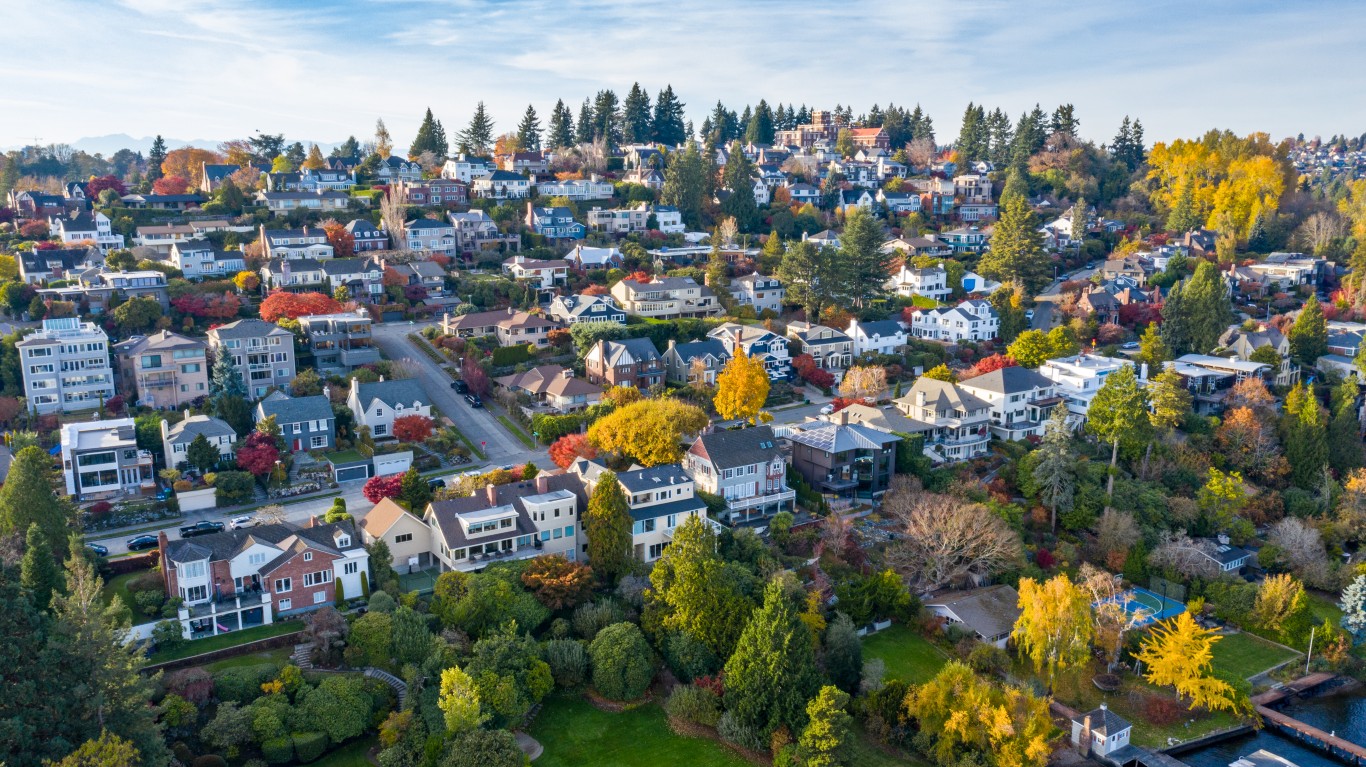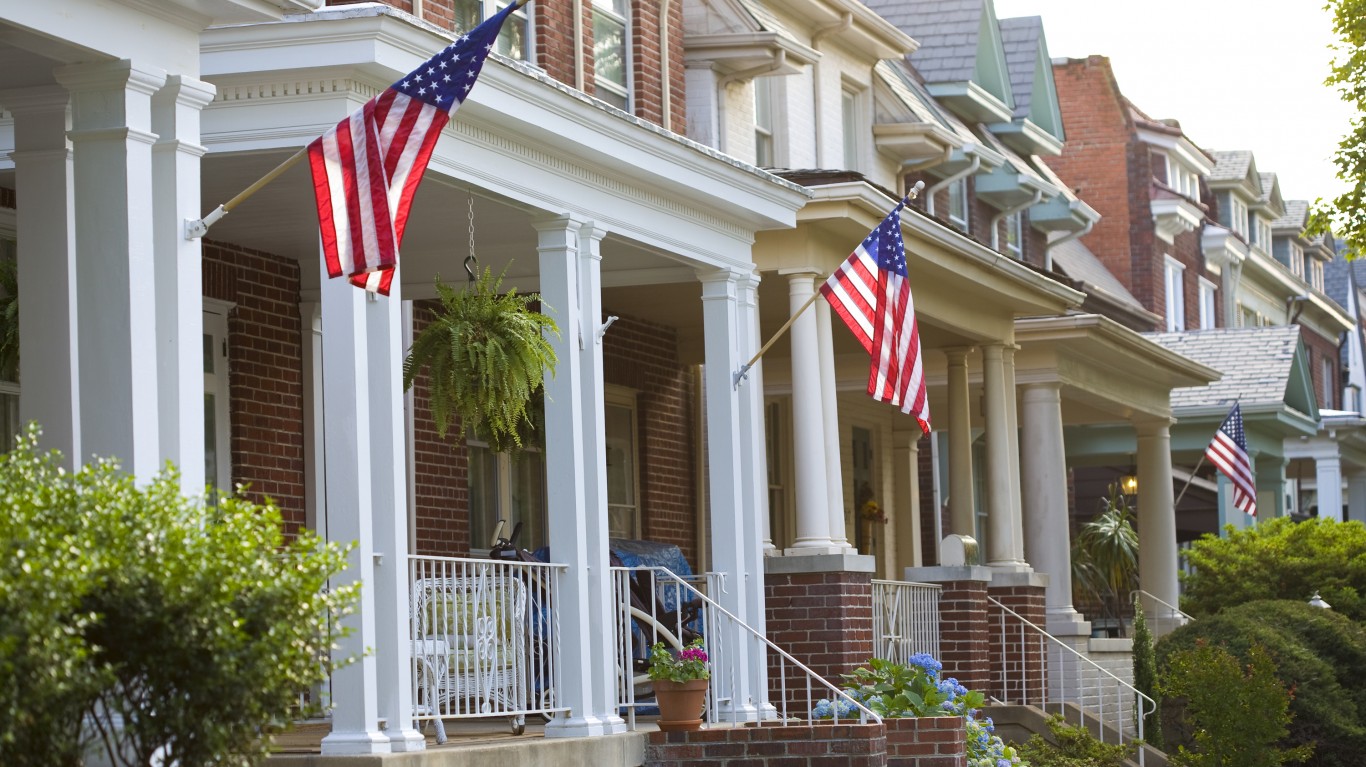
There are nearly 7,000 degree-granting colleges and graduate schools spread across the United States. These institutions of higher learning instruct those enrolled there in many fields, developing them intellectually and preparing them for specific careers. In addition to conferring degrees, colleges and universities have a broad impact on the culture and economy of their home cities and towns.
American cities whose economy and culture are widely impacted by the local universities and colleges are known simply as college towns — and are considered by many to be idyllic places to live. They tend to be affordable, culturally vibrant communities, with healthy economies and a young, well-educated population. It is certainly no coincidence that several of the best cities to live in every state are college towns.
Using data from the U.S. Census Bureau’s American Community Survey, 24/7 Wall St. identified the 30 best college towns in America. Cities were ranked based on the share of residents enrolled in a graduate or undergraduate institution. A large share of student residents is indicative of the significant influence of universities on a town.
Though the best college towns are typically home to multiple higher education institutions — from community colleges to graduate schools — most often, a single school accounts for the vast majority of students. Many of the cities on this list are home to some of the largest universities — as measured by total enrollment — in the country.
The presence of major universities in many of the cities on this list often indicates a better-educated population than average. Bachelor’s degree attainment rates in these cities are driven up by university professors and graduate program enrollment. With the sole exception of Muncie, Indiana, every city on this list is home to a larger share of adults with a bachelor’s degree than the 30.9% share of adults nationwide — some even rank among the best educated cities in the country. Here is a full list of the most educated city in each state.
Click here to see the 30 best college towns in America
Click here to read our methodology
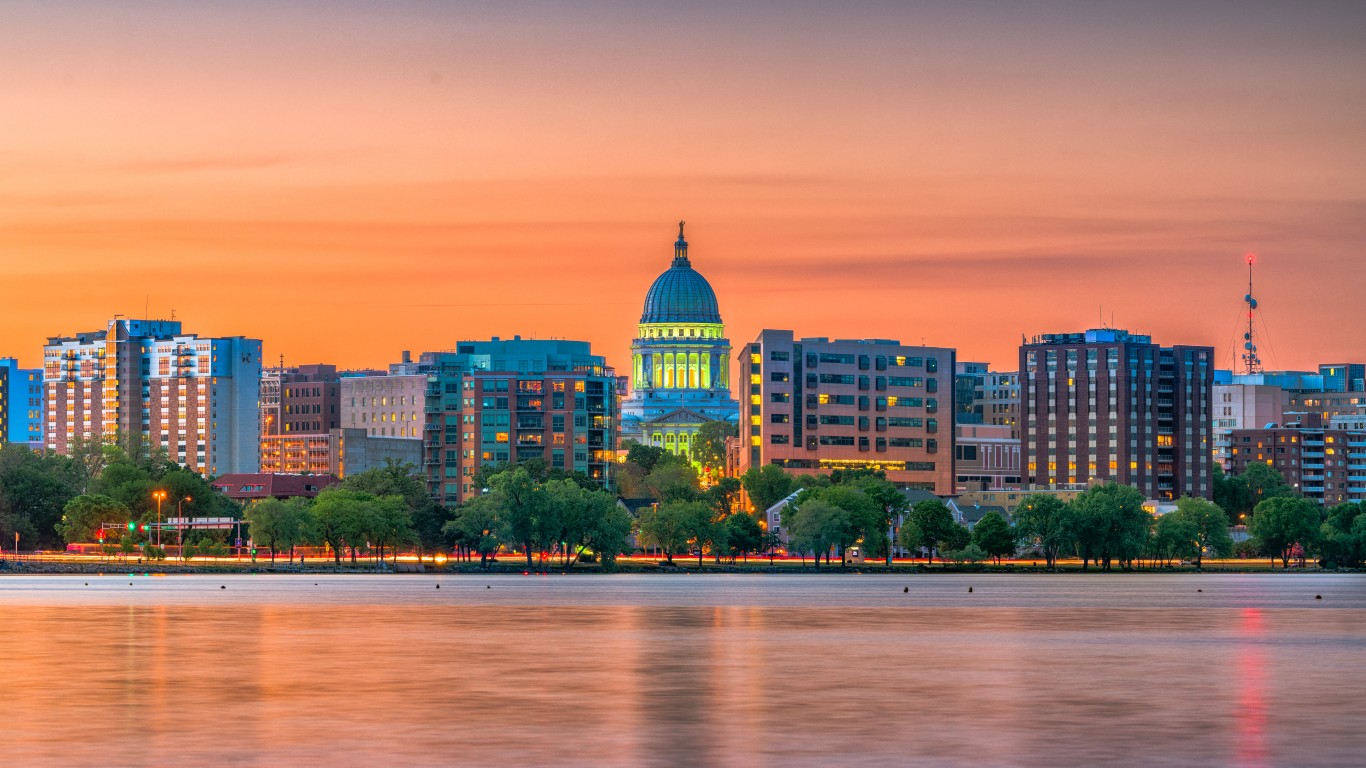
30. Madison, Wisconsin
> Pop. enrolled in college: 20.0% (49,718)
> No. of colleges and universities in the area: 15
> Adults with a bachelor’s degree: 57.1%
> Median age: 31.0
> 2018 unemployment: 2.2%
> Bars and restaurants: 319 per 100,000 people
Wisconsin’s capital city is also home to the University of Wisconsin, the largest postsecondary institution in the state. All told, there are nearly 50,000 college and graduate students living in Madison.
[in-text-ad]

29. Bellingham, Washington
> Pop. enrolled in college: 20.6% (17,551)
> No. of colleges and universities in the area: 4
> Adults with a bachelor’s degree: 43.0%
> Median age: 31.1
> 2018 unemployment: 4.5%
> Bars and restaurants: 378 per 100,000 people
The vast majority of the 17,551 college and graduate students living in Bellingham, Washington, are enrolled at Western Washington University, a public university with over 15,000 undergraduates.

28. Fort Collins, Colorado
> Pop. enrolled in college: 20.6% (32,849)
> No. of colleges and universities in the area: 5
> Adults with a bachelor’s degree: 53.6%
> Median age: 29.2
> 2018 unemployment: 2.7%
> Bars and restaurants: 261 per 100,000 people
Fort Collins, Colorado, is home to several postsecondary institutions, including Front Range Community College and Colorado State University. As is often the case in college towns, Fort Collins is a young city. The typical resident is just 29 years old, nine years younger than the median age of nearly 38 nationwide.
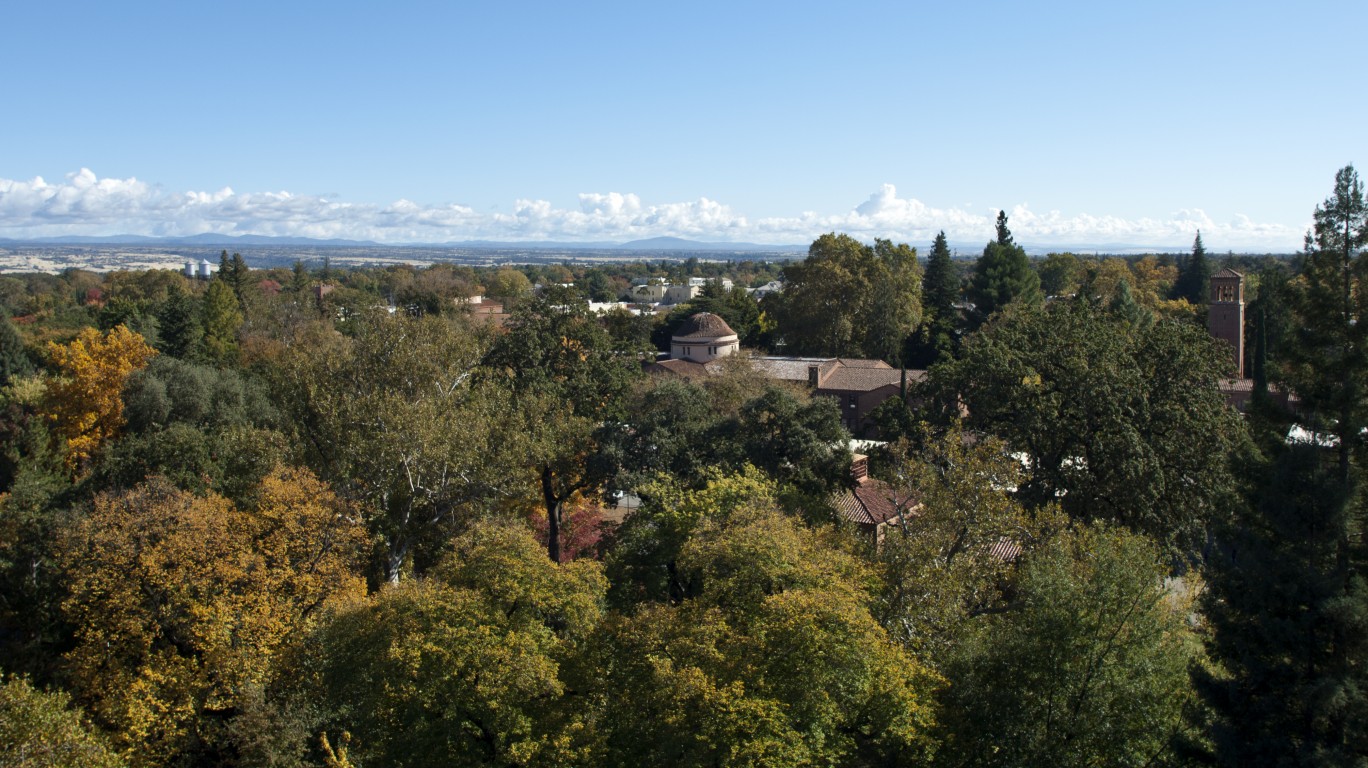
27. Chico, California
> Pop. enrolled in college: 20.8% (18,855)
> No. of colleges and universities in the area: 2
> Adults with a bachelor’s degree: 36.9%
> Median age: 29.9
> 2018 unemployment: 3.8%
> Bars and restaurants: 274 per 100,000 people
More than one in every five residents of Chico, California, are enrolled in college or graduate school. The city is home to California State University, Chico, and its more than 16,000 undergraduate students.
[in-text-ad-2]
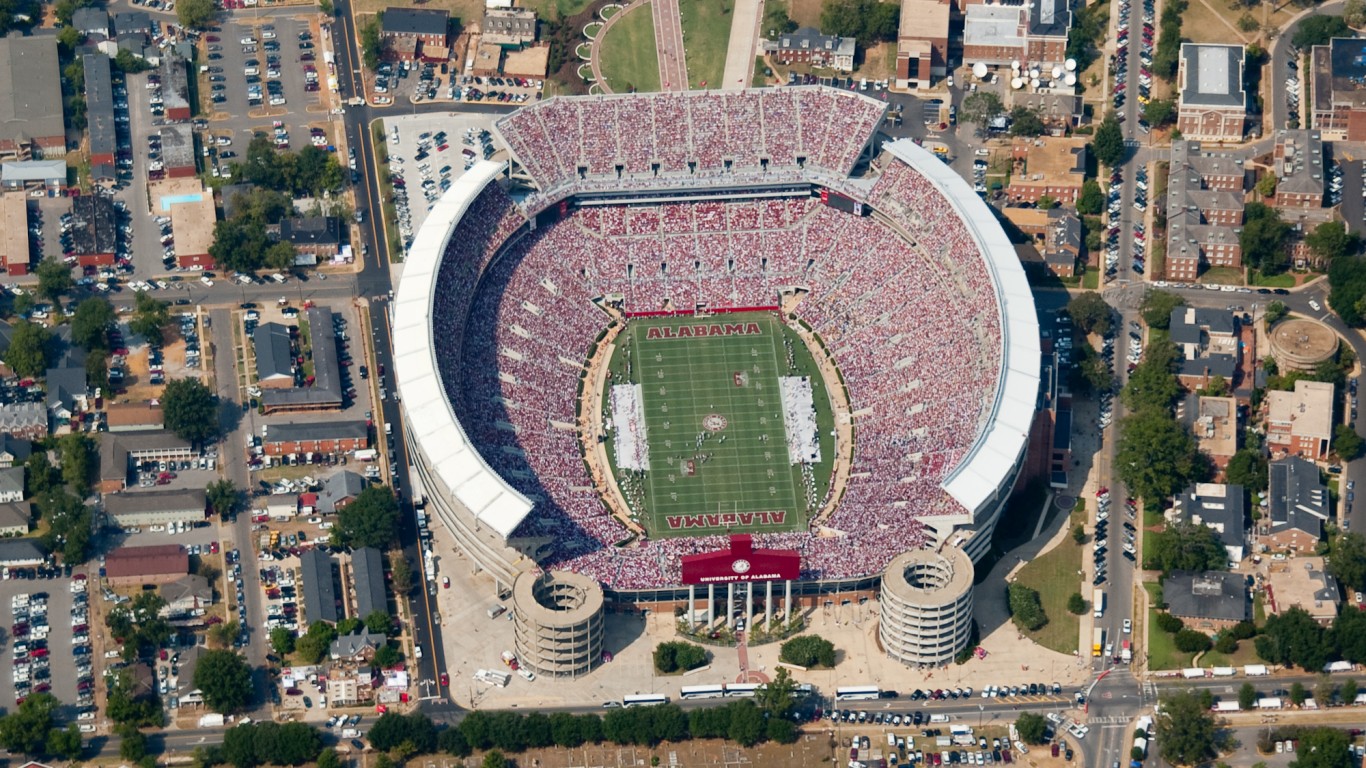
26. Tuscaloosa, Alabama
> Pop. enrolled in college: 21.4% (20,849)
> No. of colleges and universities in the area: 4
> Adults with a bachelor’s degree: 36.4%
> Median age: 28.6
> 2018 unemployment: 4.3%
> Bars and restaurants: 263 per 100,000 people
Tuscaloosa is home to the University of Alabama, one of the largest schools in the United States. As is often the case in college towns, Tuscaloosa is a young city. The typical resident is just 28.6 years old, nine years younger than the median age of 37.8 nationwide.
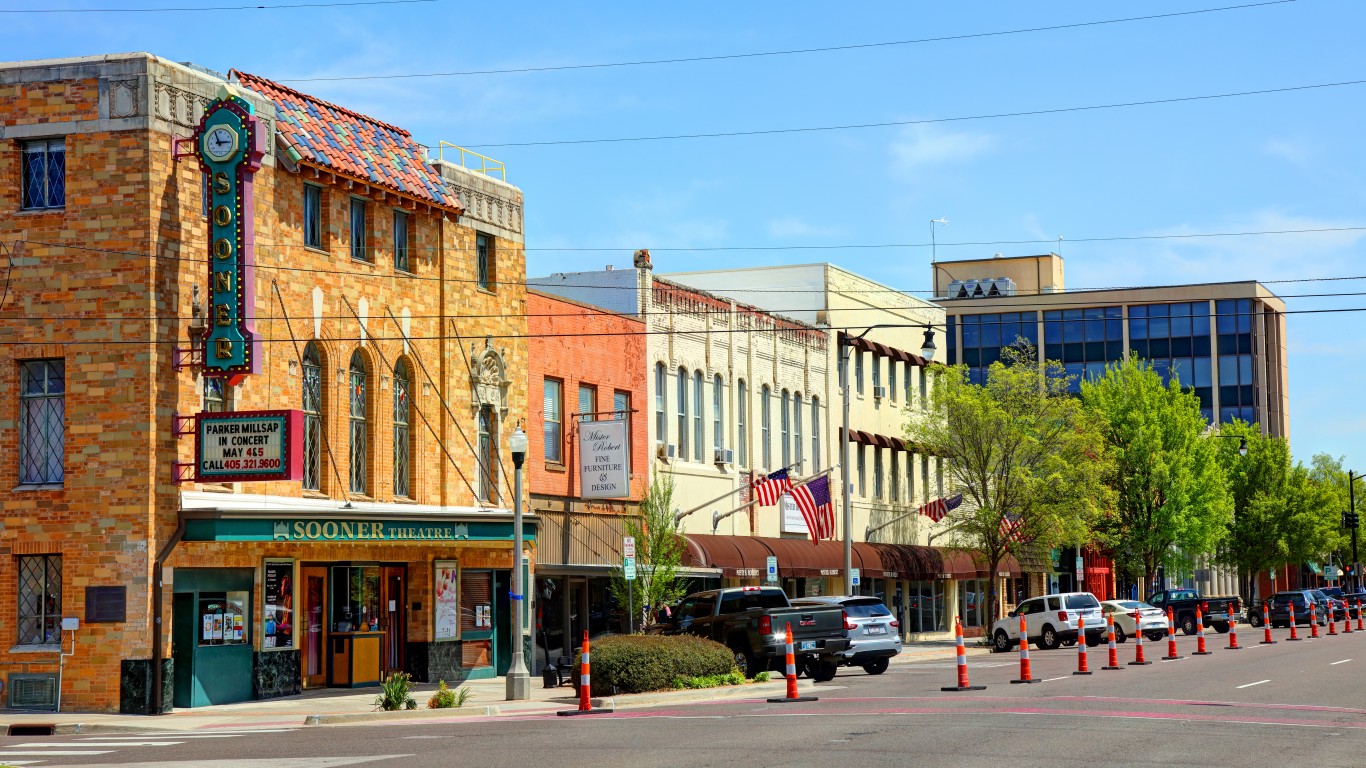
25. Norman, Oklahoma
> Pop. enrolled in college: 21.8% (26,163)
> No. of colleges and universities in the area: 3
> Adults with a bachelor’s degree: 42.1%
> Median age: 30.1
> 2018 unemployment: 2.8%
> Bars and restaurants: 236 per 100,000 people
The University of Oklahoma — a public research university with undergraduate enrollment of nearly 22,000 — is located in the city of Norman. College towns tend to have highly-educated adult populations, and Norman is no exception. Over 42% of area residents 25 and over have a bachelor’s degree, compared to 30.9% of adults nationwide.
[in-text-ad]

24. Denton, Texas
> Pop. enrolled in college: 21.9% (28,720)
> No. of colleges and universities in the area: 3
> Adults with a bachelor’s degree: 38.1%
> Median age: 29.1
> 2018 unemployment: 3.1%
> Bars and restaurants: 241 per 100,000 people
Denton is a city in the Dallas-Fort Worth metro area. Nearly 29,000 the city’s residents are enrolled in college or graduate school. The city is home to the University of North Texas.
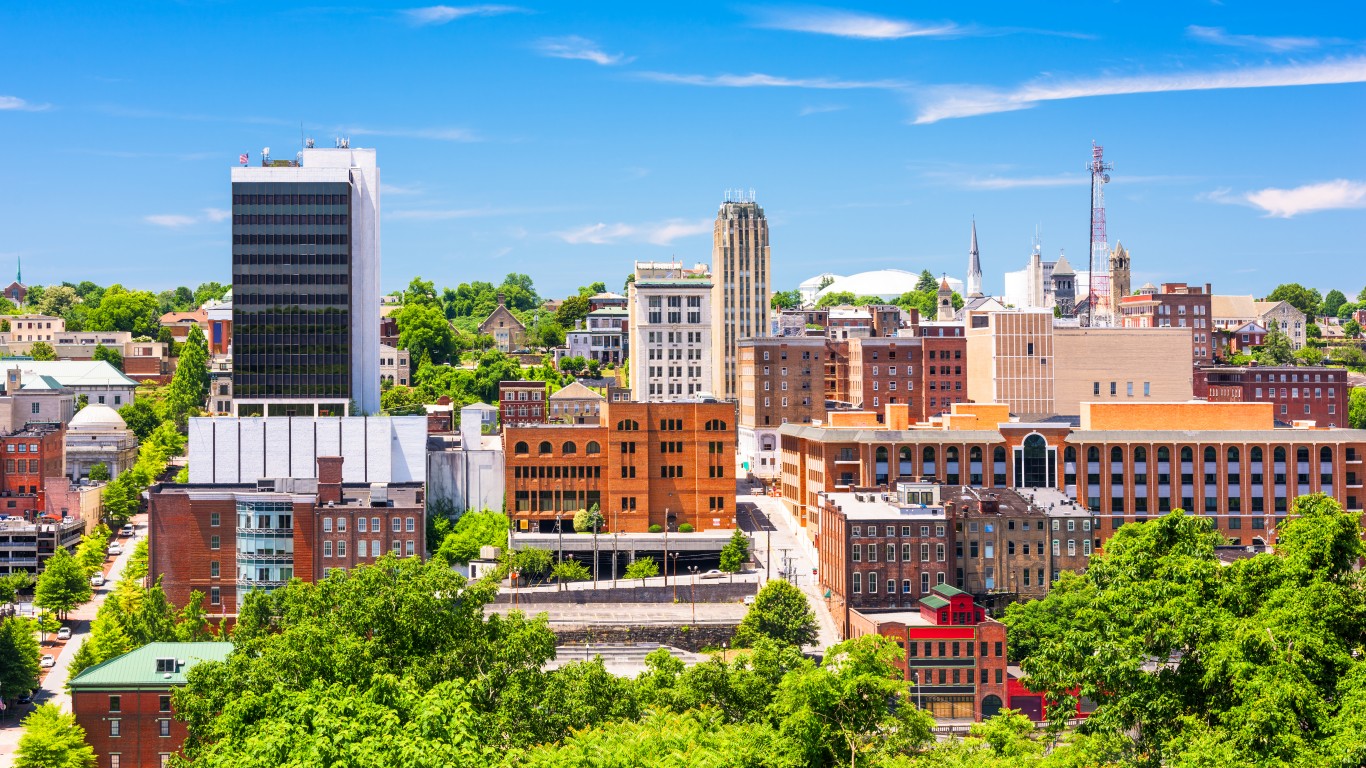
23. Lynchburg, Virginia
> Pop. enrolled in college: 22.2% (17,628)
> No. of colleges and universities in the area: 8
> Adults with a bachelor’s degree: 33.6%
> Median age: 28.3
> 2018 unemployment: 4.0%
> Bars and restaurants: 272 per 100,000 people
Of the more than 79,000 people living in Lynchburg, 22.2% are college students. The city is home to Liberty University and University of Lynchburg, two private Christian institutions.

22. Muncie, Indiana
> Pop. enrolled in college: 23.4% (16,234)
> No. of colleges and universities in the area: 2
> Adults with a bachelor’s degree: 23.6%
> Median age: 28.8
> 2018 unemployment: 4.3%
> Bars and restaurants: 226 per 100,000 people
Muncie, Indiana, is home to two postsecondary institutions, Ball State University and Ivy Tech Community College. Of the city’s 69,000 residents, 23.4% are enrolled in college or graduate school.
[in-text-ad-2]
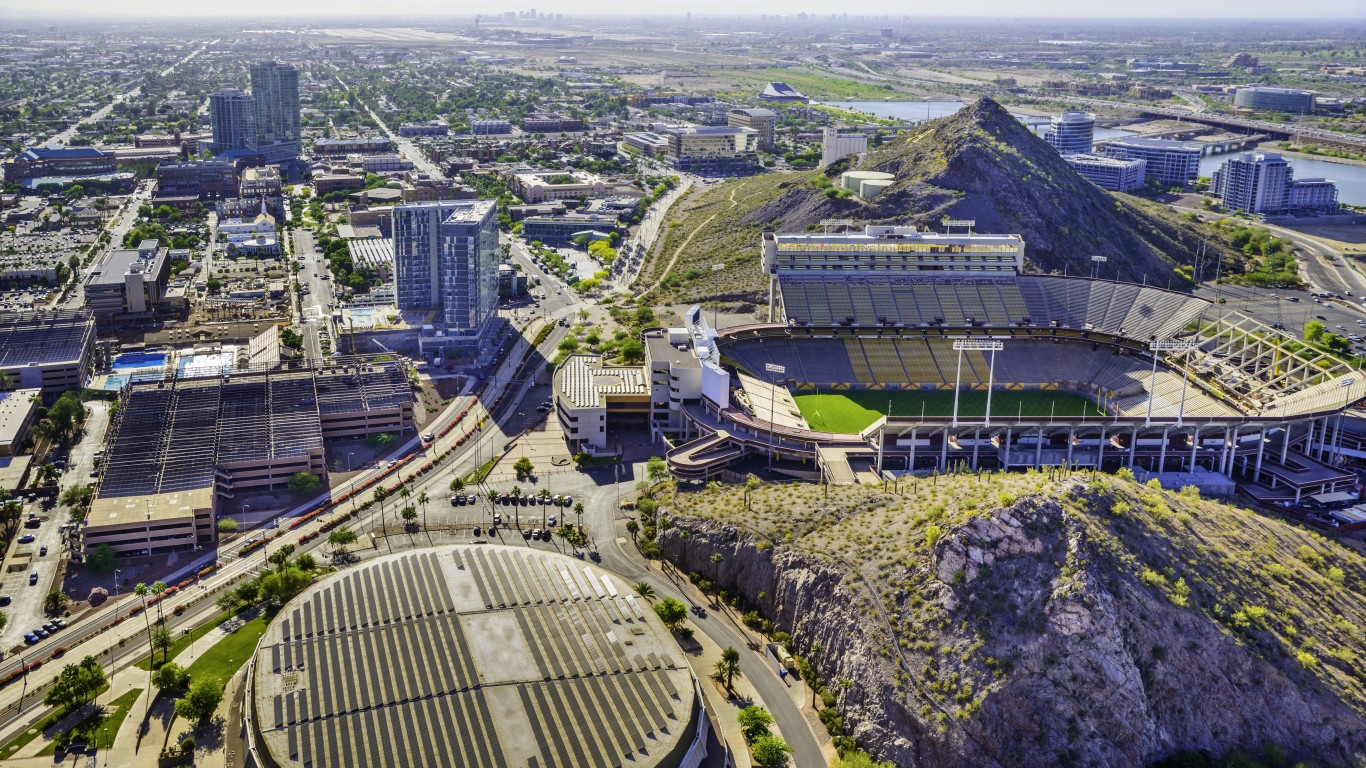
21. Tempe, Arizona
> Pop. enrolled in college: 23.7% (42,330)
> No. of colleges and universities in the area: 16
> Adults with a bachelor’s degree: 43.6%
> Median age: 28.8
> 2018 unemployment: 3.8%
> Bars and restaurants: 298 per 100,000 people
Home to a number of higher education institutions, including Arizona State University and Rio Salado College, Tempe, Arizona, has one of the largest student population in the United States, Over 42,330 Tempe residents are enrolled in college or school.
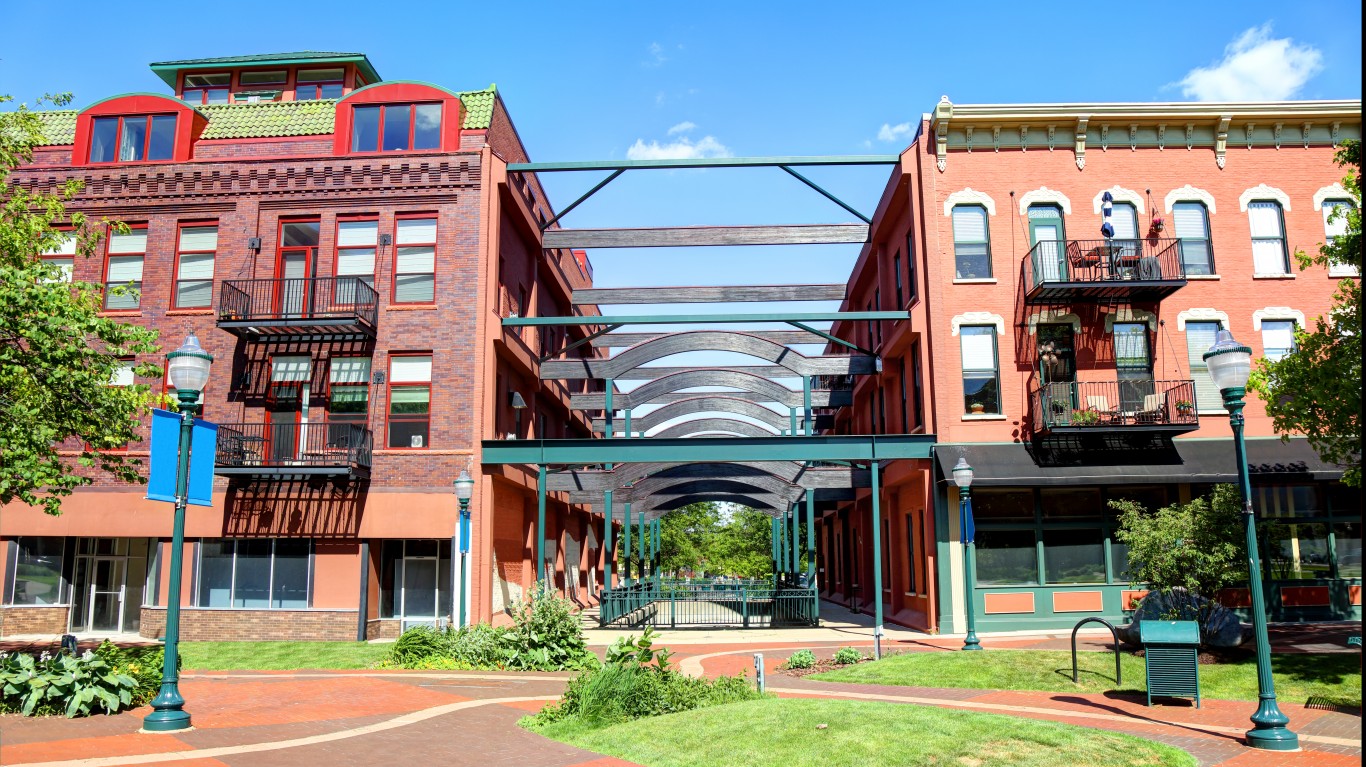
20. Kalamazoo, Michigan
> Pop. enrolled in college: 24.7% (18,761)
> No. of colleges and universities in the area: 6
> Adults with a bachelor’s degree: 34.2%
> Median age: 26.2
> 2018 unemployment: 4.3%
> Bars and restaurants: 356 per 100,000 people
Nearly one in every four residents of Kalamazoo, Michigan are enrolled in college or graduate school. The city is home to half a dozen schools, including Western Michigan University, Kalamazoo College, and Kalamazoo Valley Community College.
[in-text-ad]

19. Lawrence, Kansas
> Pop. enrolled in college: 25.6% (24,038)
> No. of colleges and universities in the area: 4
> Adults with a bachelor’s degree: 53.4%
> Median age: 27.5
> 2018 unemployment: 3.0%
> Bars and restaurants: 267 per 100,000 people
Home to four postsecondary institutions — including the University of Kansas, the largest university in the state — Lawrence, Kansas, ranks among the top 20 college towns in the United States. College towns tend to have highly-educated adult populations, and Lawrence is no exception. Over half of area residents 25 and over hold a bachelor’s degree, compared to 30.9% of adults nationwide.
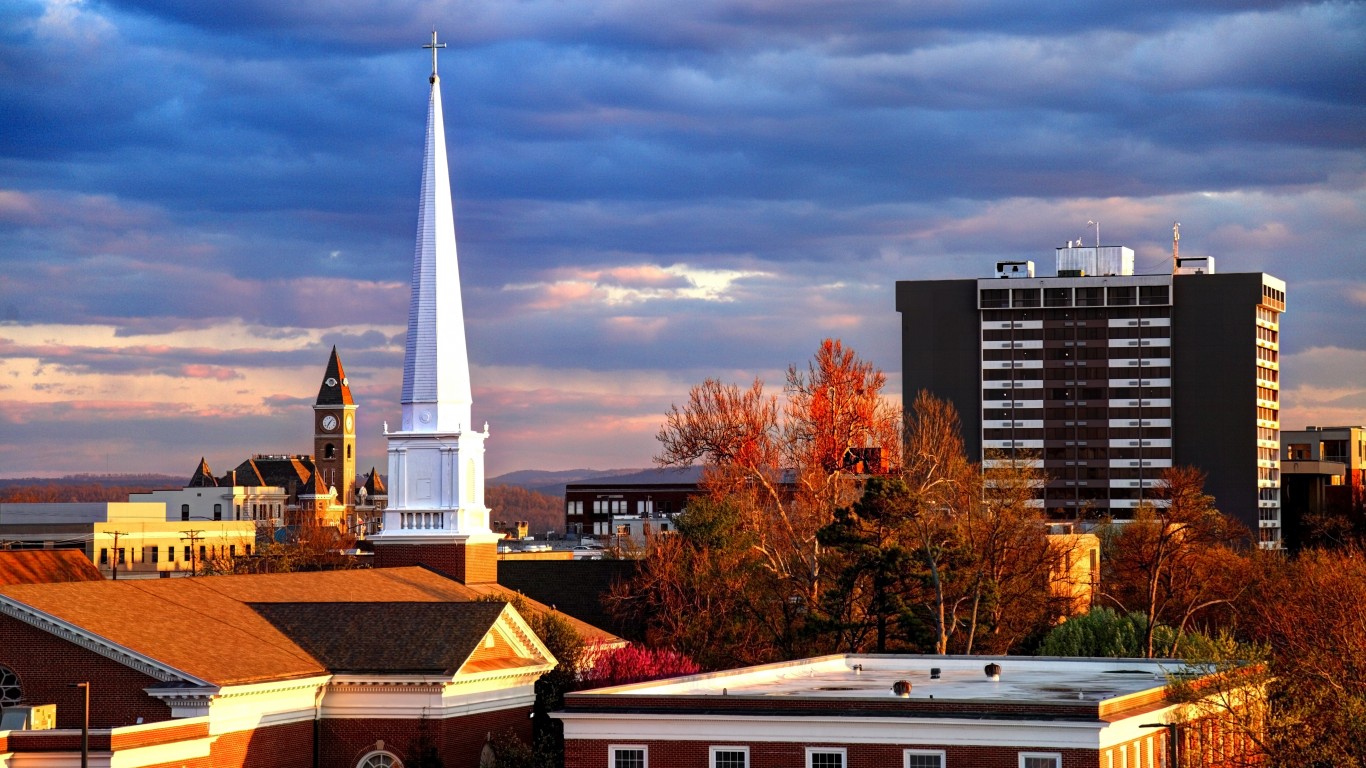
18. Fayetteville, Arkansas
> Pop. enrolled in college: 26.0% (21,270)
> No. of colleges and universities in the area: 3
> Adults with a bachelor’s degree: 48.1%
> Median age: 27.1
> 2018 unemployment: 2.7%
> Bars and restaurants: 366 per 100,000 people
Fayetteville, Arkansas, boasts three postsecondary education institutions, including the University of Arkansas, and 26% of area residents are enrolled in undergraduate or postgraduate degree programs. College towns often have a larger than typical range of options related to culture and entertainment — and in Fayetteville, there are 366 bars and restaurants for every 100,000 people, a far greater concentration than the national concentration of 186 per 100,000.

17. Columbia, Missouri
> Pop. enrolled in college: 26.1% (30,937)
> No. of colleges and universities in the area: 7
> Adults with a bachelor’s degree: 53.4%
> Median age: 27.6
> 2018 unemployment: 2.3%
> Bars and restaurants: 278 per 100,000 people
Columbia, Missouri is home to the University of Missouri â Columbia, commonly known as Mizzou, the state’s flagship university. Columbia has seven colleges in the area, and ranks among the top college towns in the country. Of the city’s 118,600 residents, 26.1% are enrolled in college or graduate school.
[in-text-ad-2]
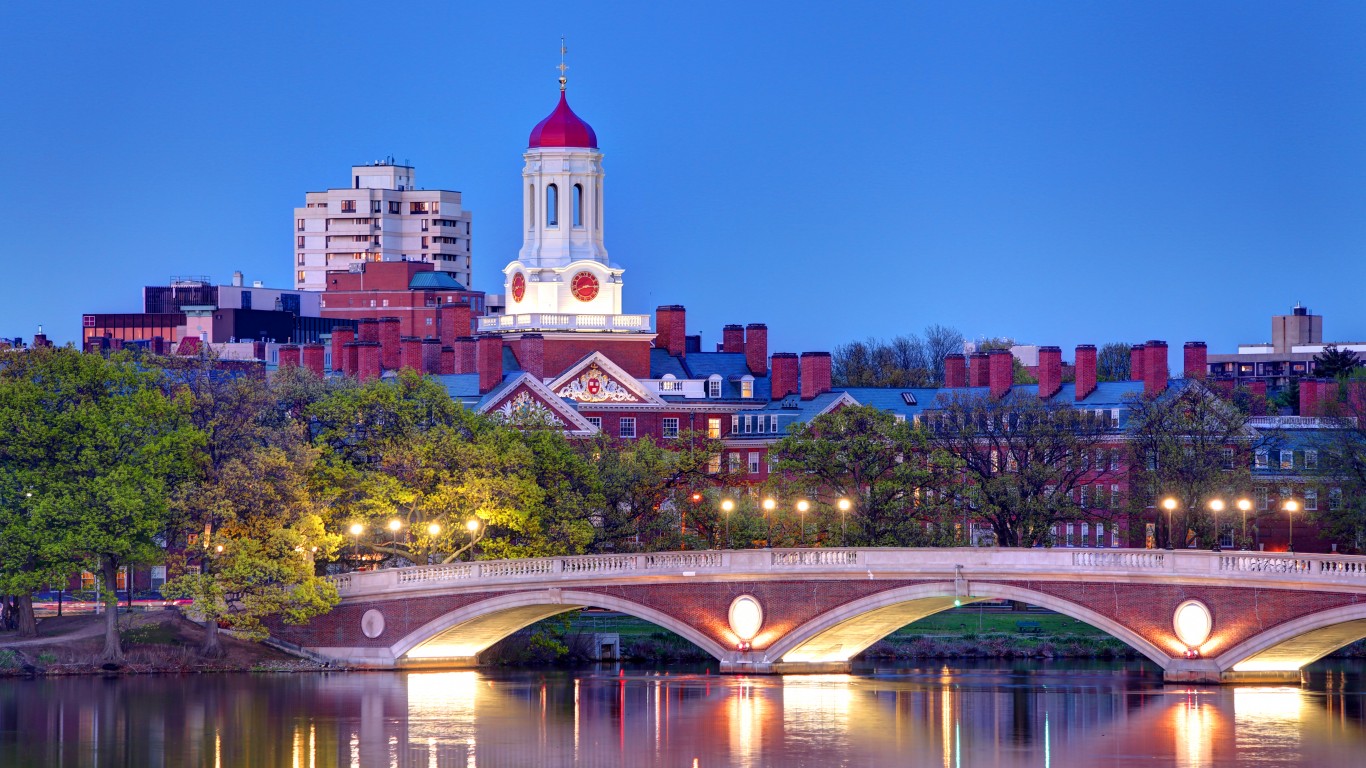
16. Cambridge, Massachusetts
> Pop. enrolled in college: 26.3% (29,184)
> No. of colleges and universities in the area: 7
> Adults with a bachelor’s degree: 76.5%
> Median age: 30.4
> 2018 unemployment: 2.1%
> Bars and restaurants: 350 per 100,000 people
Cambridge, Massachusetts, located across the Charles River from Boston, is home to some of the most competitive universities in the country, including MIT and Harvard University. Areas home to large student populations often also have well-educated adult populations. In Cambridge, more than 75% residents 25 and over hold a bachelor’s degree, compared to just 30.9% of adults nationwide.

15. Athens-Clarke County, Georgia
> Pop. enrolled in college: 26.8% (32,743)
> No. of colleges and universities in the area: 3
> Adults with a bachelor’s degree: 41.3%
> Median age: 27.2
> 2018 unemployment: N/A
> Bars and restaurants: 273 per 100,000 people
Athens, Georgia, is home to the largest university in the state, the University of Georgia. Nearly 33,000 city residents, or over one-quarter of the total population, are enrolled in college or graduate school.
[in-text-ad]

14. Tallahassee, Florida
> Pop. enrolled in college: 28.0% (52,729)
> No. of colleges and universities in the area: 9
> Adults with a bachelor’s degree: 48.0%
> Median age: 26.6
> 2018 unemployment: 3.6%
> Bars and restaurants: 299 per 100,000 people
Florida’s capital city is also one of only two cities in the state to rank among America’s best college towns. The city is home to nine postsecondary education institutions, including Florida A&M, Tallahassee Community College, and Florida State University, one of the largest universities in the country.
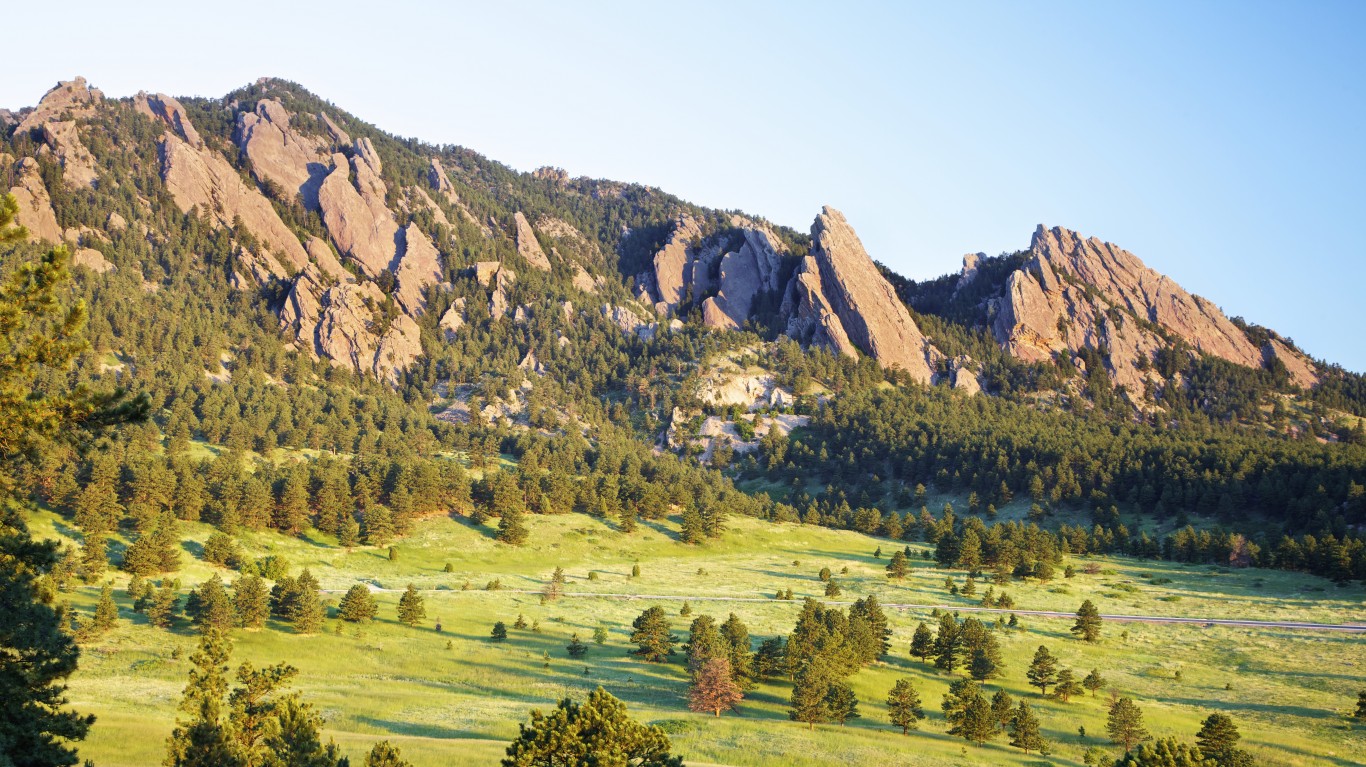
13. Boulder, Colorado
> Pop. enrolled in college: 28.6% (30,411)
> No. of colleges and universities in the area: 6
> Adults with a bachelor’s degree: 73.8%
> Median age: 28.6
> 2018 unemployment: 2.7%
> Bars and restaurants: 342 per 100,000 people
Boulder, Colorado, is home to the University of Colorado — Boulder, a public research institution and one of the largest universities in the United States. The university helps support the city’s strong job market. Just 2.7% of Boulder’s workforce was unemployed in 2018, a far smaller share than the 3.9% national unemployment rate.
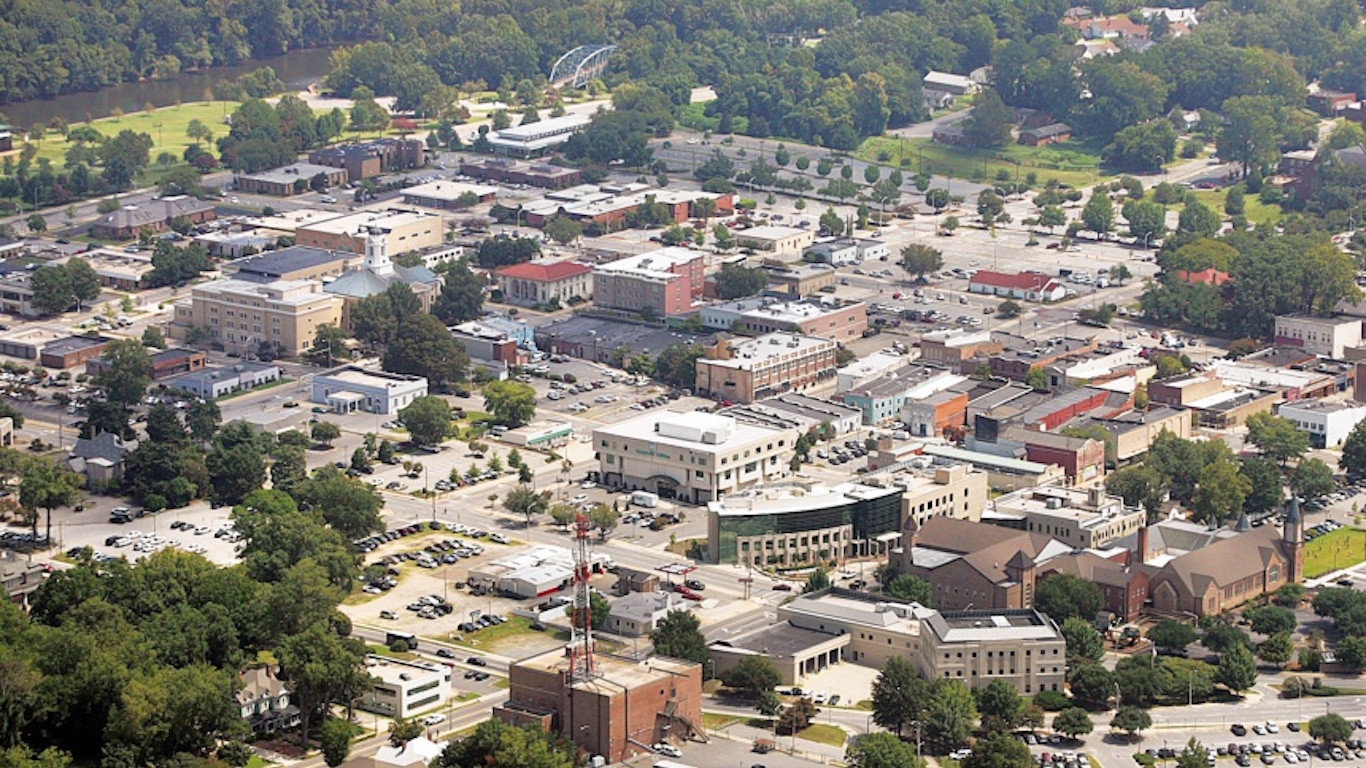
12. Greenville, North Carolina
> Pop. enrolled in college: 28.6% (25,861)
> No. of colleges and universities in the area: 4
> Adults with a bachelor’s degree: 38.3%
> Median age: 26.8
> 2018 unemployment: 4.5%
> Bars and restaurants: 281 per 100,000 people
Nearly 29% of the 90,300 people living in Greenville, North Carolina, are enrolled in a graduate or undergraduate degree program. The small city boasts four higher education institutions, including East Carolina University and Pitt Community College.
[in-text-ad-2]
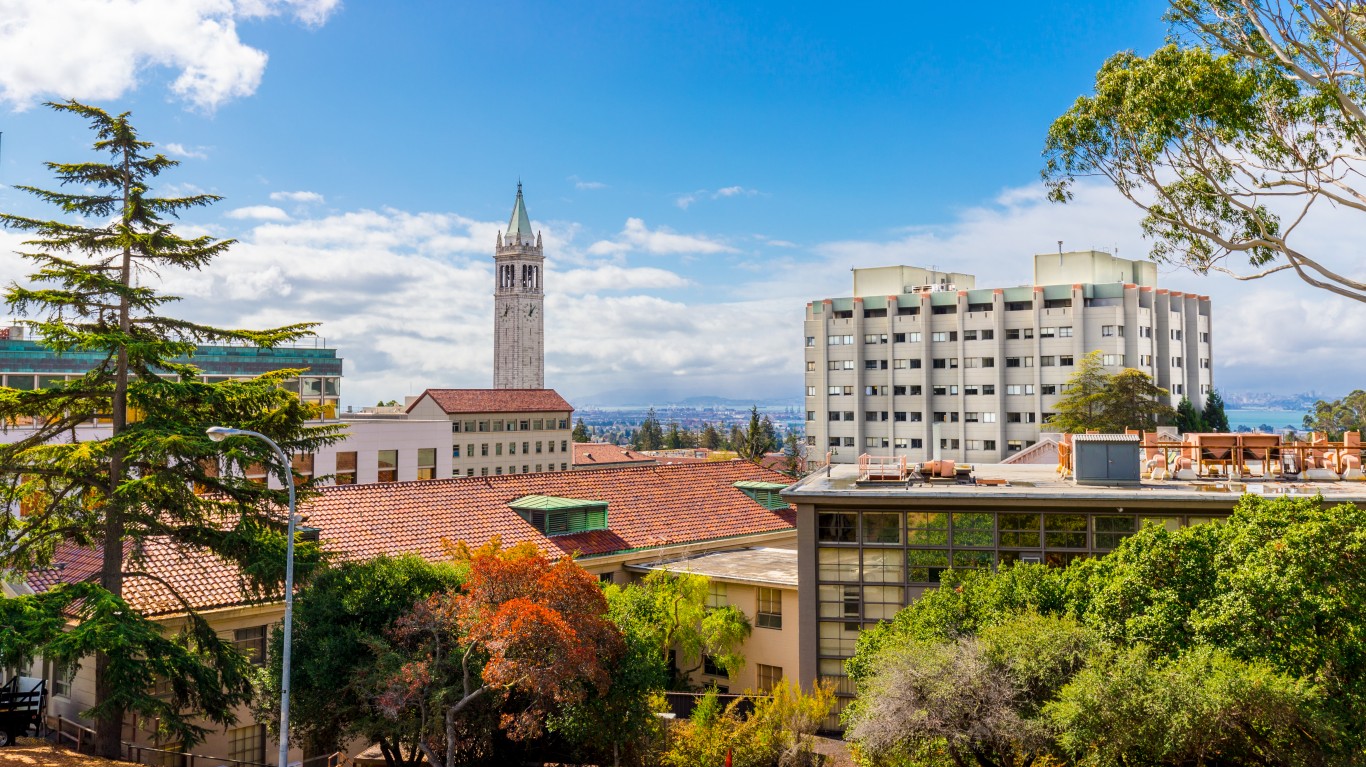
11. Berkeley, California
> Pop. enrolled in college: 29.0% (34,798)
> No. of colleges and universities in the area: 12
> Adults with a bachelor’s degree: 72.3%
> Median age: 31.0
> 2018 unemployment: 2.8%
> Bars and restaurants: 362 per 100,000 people
Nearly 35,000 of Berkeley, California’s 120,200 residents are enrolled in college or graduate degree programs. The city is home to a dozen higher education institutions, including the University of California, Berkeley — the oldest and most selective school in the UC system.

10. Champaign, Illinois
> Pop. enrolled in college: 30.5% (26,154)
> No. of colleges and universities in the area: 2
> Adults with a bachelor’s degree: 51.1%
> Median age: 27.2
> 2018 unemployment: 4.3%
> Bars and restaurants: 344 per 100,000 people
The University of Illinois at Urbana-Champaign is one of the largest universities in the United States — and its home city of Champaign, Illinois, ranks among the best college towns as a result. Champaign is one of only 10 U.S. cities with populations of at least 65,000 residents where over 30% of the population is enrolled in college or graduate school.
[in-text-ad]

9. Flagstaff, Arizona
> Pop. enrolled in college: 32.0% (22,347)
> No. of colleges and universities in the area: 4
> Adults with a bachelor’s degree: 45.1%
> Median age: 25.1
> 2018 unemployment: 3.9%
> Bars and restaurants: 325 per 100,000 people
Thanks in large part to the presence of Northern Arizona University, 32% of Flagstaff, Arizona, residents are college and graduate students. Towns where a college or university is a defining feature tend to be relatively young areas. In Flagstaff, the typical resident is only 25.1 years old, about 13 years younger than the median age of 37.8 nationwide.

8. Provo, Utah
> Pop. enrolled in college: 32.9% (38,244)
> No. of colleges and universities in the area: 8
> Adults with a bachelor’s degree: 42.5%
> Median age: 23.7
> 2018 unemployment: 2.7%
> Bars and restaurants: 136 per 100,000 people
Nearly one in every three residents of Provo, Utah, are enrolled in college or graduate school, the largest share of any city in the state and eighth largest nationwide. The city is home to Brigham Young University, a school operated by the Mormon Church and one of the largest private universities in the country.
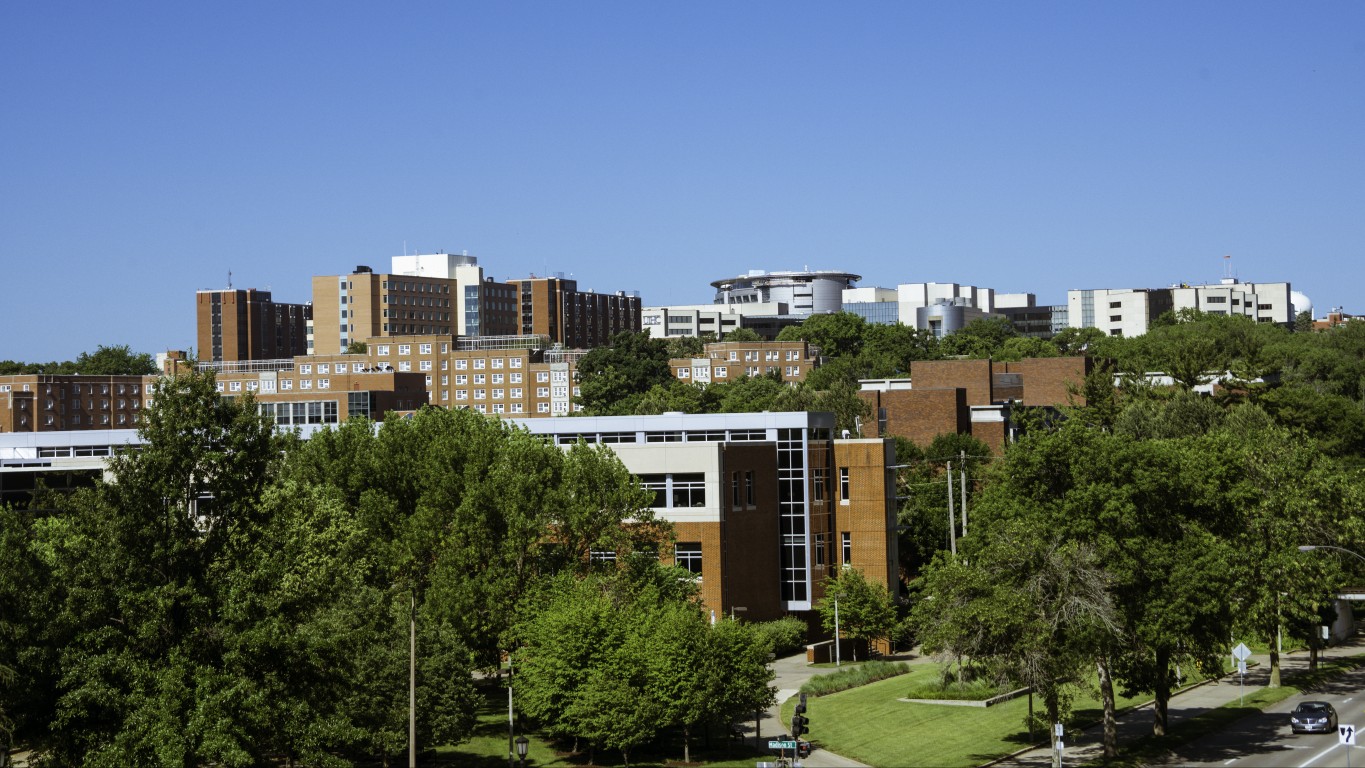
7. Iowa City, Iowa
> Pop. enrolled in college: 34.4% (25,276)
> No. of colleges and universities in the area: 3
> Adults with a bachelor’s degree: 59.9%
> Median age: 25.8
> 2018 unemployment: 1.9%
> Bars and restaurants: 274 per 100,000 people
Iowa City — home to the University of Iowa — is one of only seven U.S. cities with at least 65,000 residents where over a third of the population is enrolled in college or graduate school. A young city, the typical Iowa City resident is only 25.8 years old, 12 years younger than the median age of 37.8 nationwide.
[in-text-ad-2]

6. Ann Arbor, Michigan
> Pop. enrolled in college: 35.0% (41,716)
> No. of colleges and universities in the area: 4
> Adults with a bachelor’s degree: 74.2%
> Median age: 27.5
> 2018 unemployment: 2.5%
> Bars and restaurants: 362 per 100,000 people
Ann Arbor is home to the University of Michigan, one of the largest universities in the United States. The university helps support the city’s strong job market. Just 2.5% of Ann Arbor’s workforce was unemployed in 2018, a far smaller share than the 3.9% national unemployment rate.

5. Gainesville, Florida
> Pop. enrolled in college: 35.5% (45,938)
> No. of colleges and universities in the area: 9
> Adults with a bachelor’s degree: 43.1%
> Median age: 26.0
> 2018 unemployment: 3.7%
> Bars and restaurants: 312 per 100,000 people
The University of Florida, one of the largest higher education institutions in the country, is located in Gainesville, Florida. As is often the case in college towns, Gaineville has a young population. The typical resident is just 26 years old, about 12 years younger than the median age of 37.8 nationwide.
[in-text-ad]
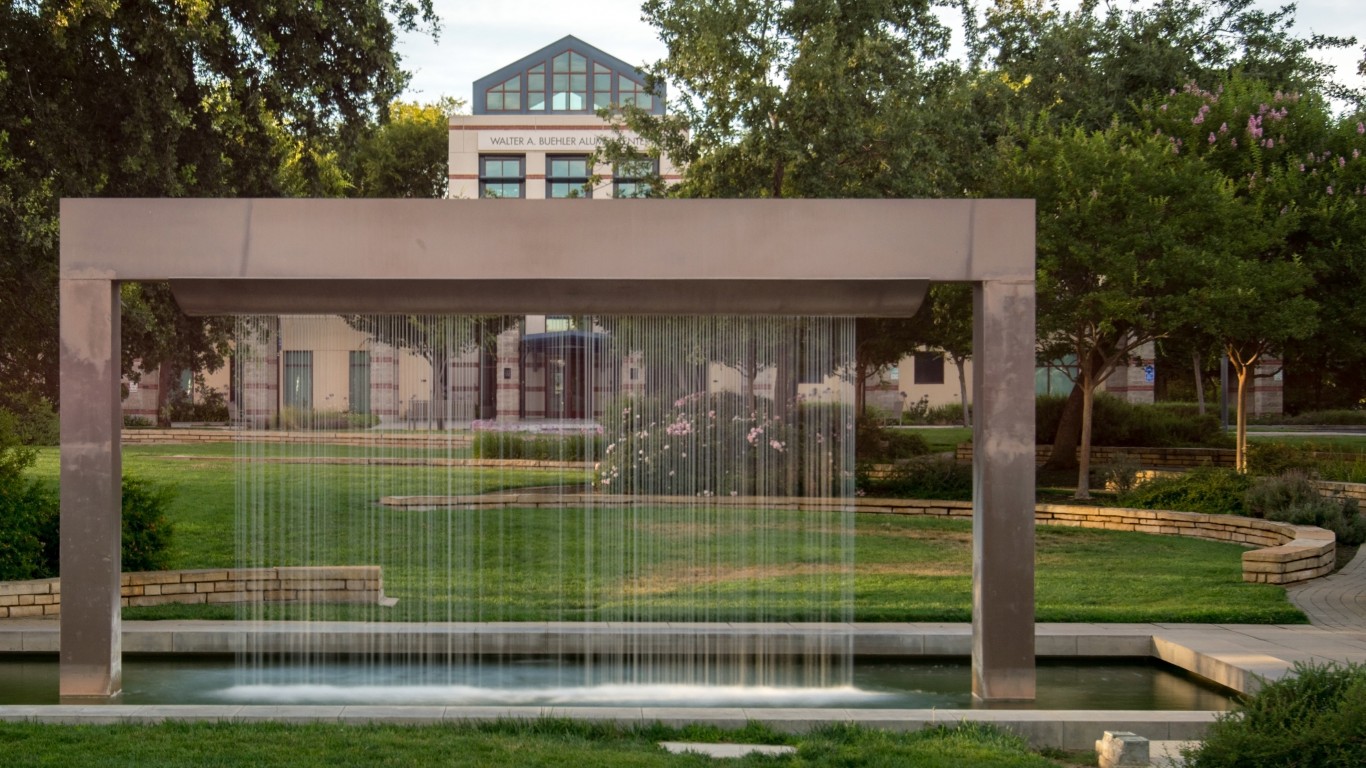
4. Davis, California
> Pop. enrolled in college: 35.7% (24,120)
> No. of colleges and universities in the area: 1
> Adults with a bachelor’s degree: 73.7%
> Median age: 25.8
> 2018 unemployment: 2.7%
> Bars and restaurants: 226 per 100,000 people
The culture and economy of Davis, California, are heavily influenced by the University of California, Davis. The school is also a major employer in the area, and partially as a result, Davis has an unemployment rate of just 2.7%, well below 3.9% national unemployment rate.

3. College Station, Texas
> Pop. enrolled in college: 42.7% (45,867)
> No. of colleges and universities in the area: 2
> Adults with a bachelor’s degree: 55.8%
> Median age: 22.7
> 2018 unemployment: 2.9%
> Bars and restaurants: 226 per 100,000 people
College Station, Texas, is one of only three U.S. cities home to at least 65,000 people where over 40% of the population is enrolled in college. The city is dominated by Texas A&M University, nearly the largest higher educational institution by enrollment in the United States.
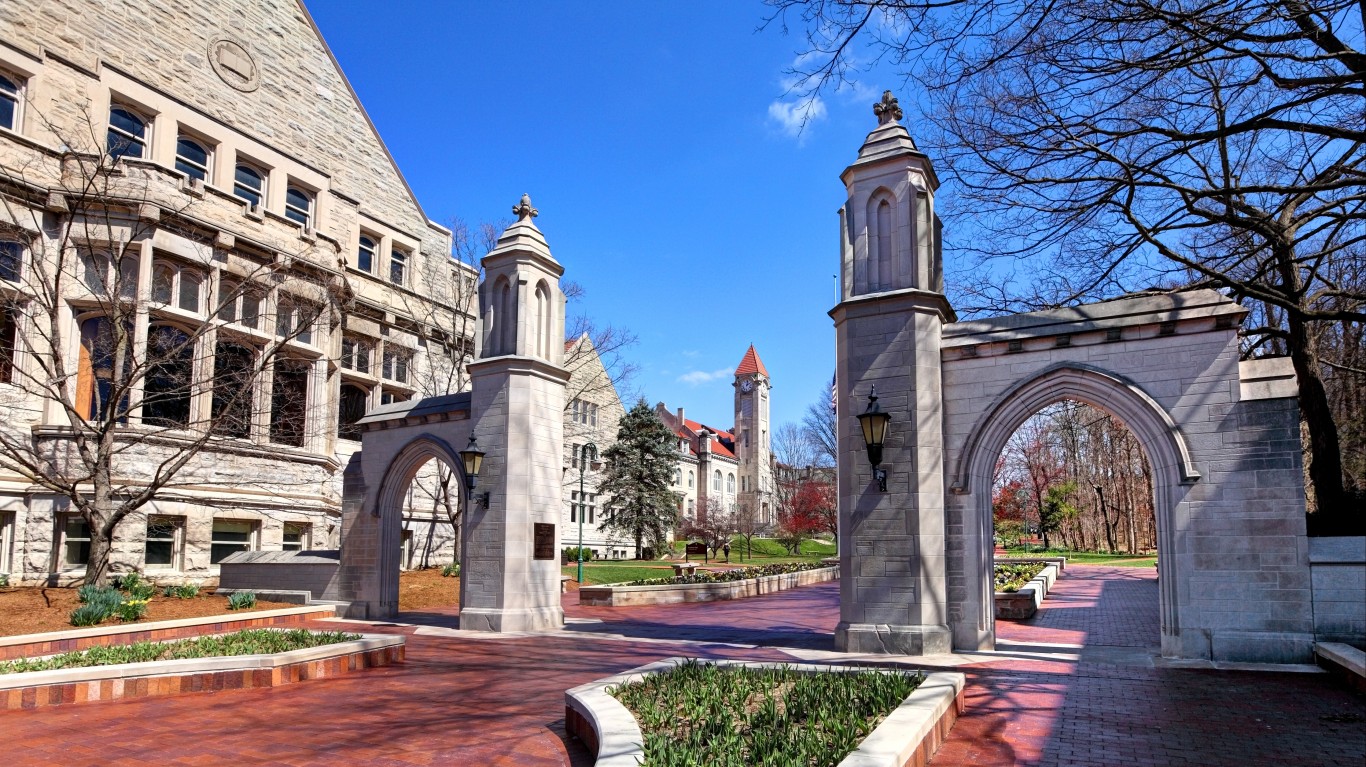
2. Bloomington, Indiana
> Pop. enrolled in college: 44.2% (36,926)
> No. of colleges and universities in the area: 2
> Adults with a bachelor’s degree: 56.8%
> Median age: 23.8
> 2018 unemployment: 3.9%
> Bars and restaurants: 329 per 100,000 people
The University of Indiana, Bloomington is one of the largest schools in the United States. Like many college towns, Bloomington has a young population. The typical resident is less than 24 years old, about 14 years younger than the median age of 37.8 nationwide.
[in-text-ad-2]
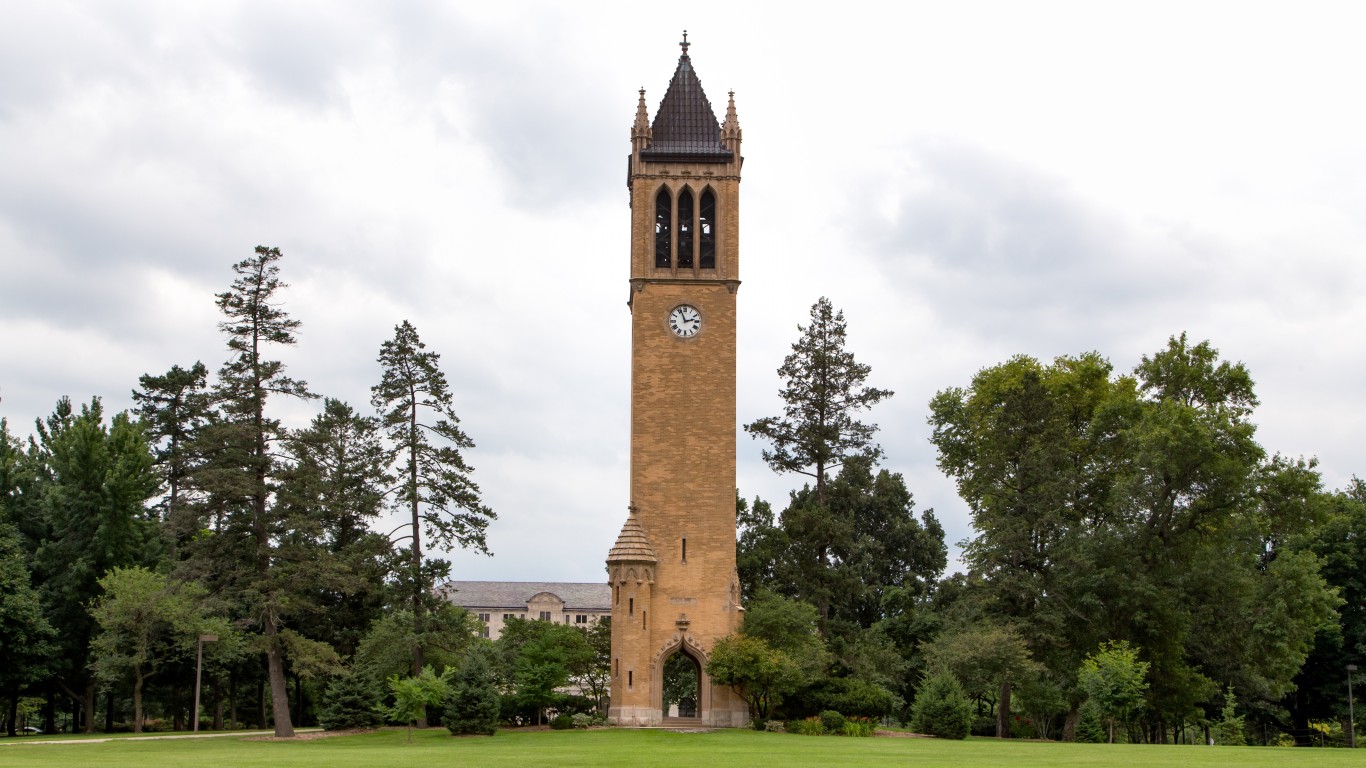
1. Ames, Iowa
> Pop. enrolled in college: 45.2% (29,369)
> No. of colleges and universities in the area: 2
> Adults with a bachelor’s degree: 62.7%
> Median age: 23.1
> 2018 unemployment: 1.5%
> Bars and restaurants: 236 per 100,000 people
Ames, Iowa, is the only U.S. city with a population of at least 65,000 where more than 45% of residents are enrolled in college or graduate school. The city is home to Iowa State University, one of the largest schools in the country. The school is a major employer in the area, and partially as a result, the unemployment rate in Ames is just 1.5%, less than half the 3.9% national unemployment rate.
Methodology
To identify the best college towns in America, 24/7 Wall St. used the data compiled from our article on the best cities to live. We considered the 584 cities, towns, and villages the U.S. Census Bureau reported as having populations of more than 65,000 in 2017. Of those places, we identified the 30 cities with the highest postsecondary enrollment as a percentage of the population.
The number of degree-granting colleges and universities (including graduate degrees) in each city as of the 2017-2018 school year comes from the National Center for Education Statistics. The percentages of adults with at least a bachelor’s degree in each city came from the U.S. Census Bureau’s 2017 American Community Survey and are 5-year estimates. Annual unemployment rates for 2018 were obtained from the Bureau of Labor Statistics. The number of bars (or “drinking places”) per 100,000 city residents came from the U.S Census Bureau’s County Business Patterns for 2016.
Credit Card Companies Are Doing Something Nuts
Credit card companies are at war. The biggest issuers are handing out free rewards and benefits to win the best customers.
It’s possible to find cards paying unlimited 1.5%, 2%, and even more today. That’s free money for qualified borrowers, and the type of thing that would be crazy to pass up. Those rewards can add up to thousands of dollars every year in free money, and include other benefits as well.
We’ve assembled some of the best credit cards for users today. Don’t miss these offers because they won’t be this good forever.
Flywheel Publishing has partnered with CardRatings for our coverage of credit card products. Flywheel Publishing and CardRatings may receive a commission from card issuers.
Thank you for reading! Have some feedback for us?
Contact the 24/7 Wall St. editorial team.
 24/7 Wall St.
24/7 Wall St. 24/7 Wall St.
24/7 Wall St. 24/7 Wall St.
24/7 Wall St. 24/7 Wall St.
24/7 Wall St.
